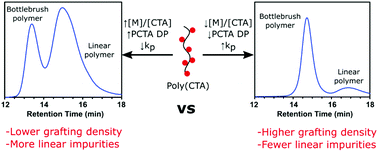Factors affecting bottlebrush polymer synthesis by the transfer-to method using reversible addition–fragmentation chain transfer (RAFT) polymerization†
Abstract
The transfer-to method is a unique way to prepare bottlebrush polymers by reversible addition–fragmentation chain transfer (RAFT) polymerization. This little-studied bottlebrush polymer synthesis strategy is distinct from the grafting-from, grafting-to, and grafting-through strategies and therefore may have specific advantages over these other synthetic approaches. Herein, we study the factors affecting the composition of bottlebrush polymer samples prepared by RAFT transfer-to, with particular emphasis on bottlebrush polymer molecular weight (MW) and dispersity (Đ) and the percentage of “dead” linear polymer as a function of initiator concentration, [M]/[CTA] ratio, backbone length, and monomer type. The lowest quantities of dead polymer were obtained under conditions that limited the MW of the bottlebrush polymer side-chains and that discouraged termination reactions. Under optimized conditions, high MW bottlebrush polymers were prepared with low dispersities and few dead polymer impurities.



 Please wait while we load your content...
Please wait while we load your content...